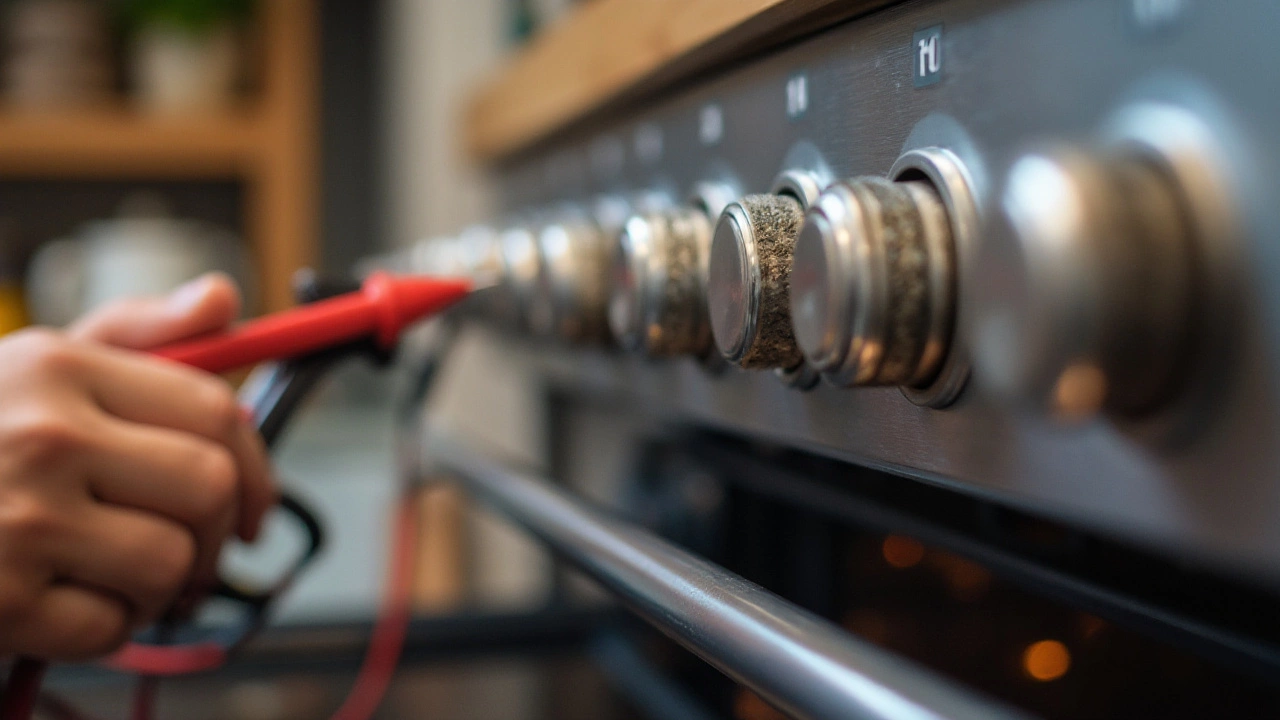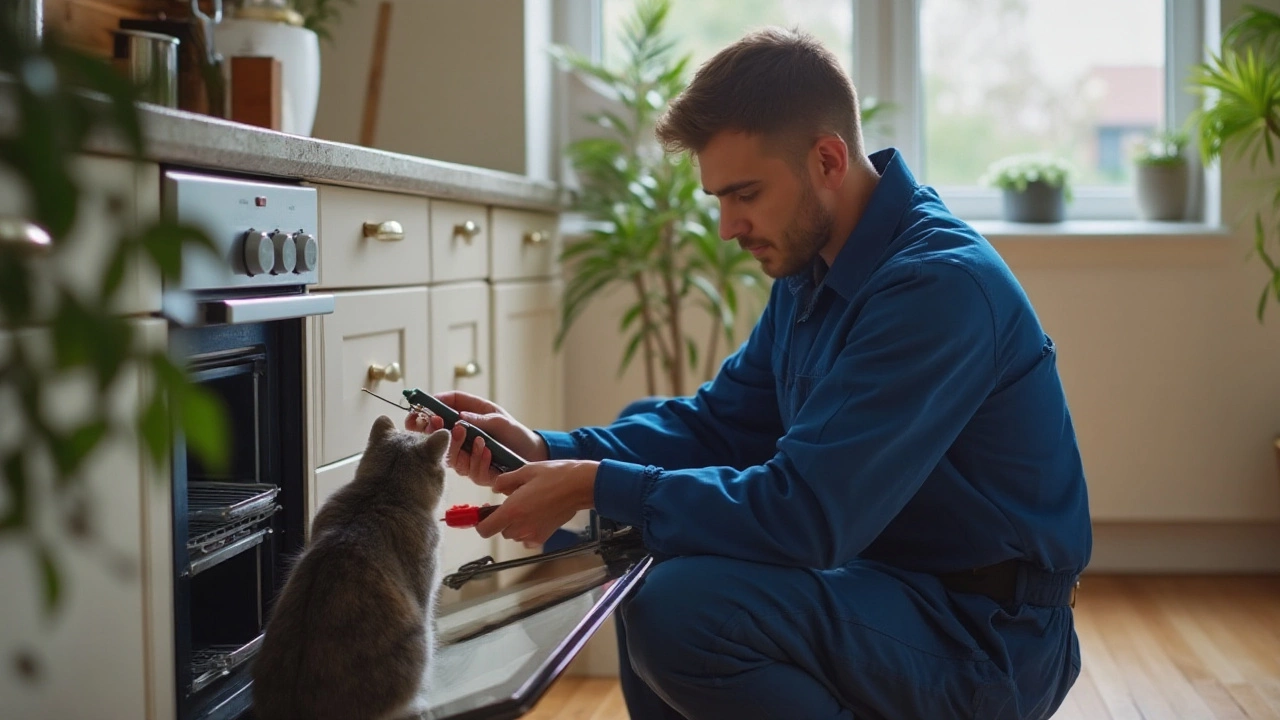There's something heartbreakingly disappointing about preparing a meal, only to find out your oven refuses to heat. It's a problem many have encountered at one point or another, sparking frustration and questions about repair costs.
Before you rush to throw your wallet at the problem, take a moment to understand the nature of the beast. Several common culprits might be to blame—from heating elements that have run their course to thermostats that have lost sensitivity to temperature.
This article aims to be your handy guide, taking you through the labyrinth of possible issues, helping you figure out when you can save costs by donning your DIY hat, and when you might want to call in the pros. Whether you're curious about actual repair costs or looking for preventive measures to avoid future mishaps, we've got you covered.
- Common Reasons for Oven Heating Issues
- DIY Troubleshooting Tips
- When to Call a Professional
- Cost Breakdown of Common Repairs
- Preventive Maintenance Tips
Common Reasons for Oven Heating Issues
Navigating the murky waters of why your oven won't heat can feel like an adventure you didn't sign up for. But fear not, even the best of appliances sometimes stumble. One of the primary suspects tends to be the heating elements themselves. These are the guts of any electric oven, crucial for converting electricity into that comforting warmth. Over time, these elements can burn out or crack, rendering them incapable of performing their basic duty. If you notice visible damage or no distinct glow when turned on, the elements might need replacement.
Next, let's turn the spotlight on the thermostat. This tiny component plays a significant role by regulating the temperature inside the oven. If your electric oven is erratic, undercooking, or failing to heat up entirely, a faulty thermostat might be the shadowy villain in your story. Picture it as a symphony conductor—when it skips a beat, the whole performance is thrown off. Calibration might solve minor quirks, but serious faults often require a replacement to restore harmony.
Imagine, for a moment, a complex web of connections beneath the surface—this is the wiring of your oven. Miswiring from the start or wear and tear over time can disrupt the flow of electricity, resulting in inconsistent heating or no heat at all. Bear in mind that fiddling with wiring, though potentially cost-saving, is not for the faint-hearted or inexperienced. It’s a game of patience and precision, often best left to a professional who cracks an enigmatic code daily.
The control board acts like the motherboard in a computer, managing every operation of your appliance. It’s the brain that keeps things running smoothly. But, when it falters, it can trigger a cascade of malfunctions, including heating issues. Diagnosing control board failures requires technical know-how and an oscilloscope to check for voltage inconsistencies.
Sometimes, the issue isn't one of the big players but rather simpler, minor components like thermal fuses or a broken door switch. These smaller parts serve a big purpose by offering safety and feedback to your oven system. Should they fail, their replacement is often cost-effective and can restore the oven’s function.
As appliance expert Miguel Ericson notes, "A little preventative maintenance goes a long way. Knowing the common issues in your oven helps catch small problems before they turn big."
Finally, environmental factors also contribute. If your local electricity supply is inconsistent or prone to surges, it can shorten the lifespan of the oven's components. Protecting your appliance with proper surge protection could be a wise investment in longevity.
DIY Troubleshooting Tips
When your oven repair becomes inevitable due to heating issues, knowing where to start can save both time and stress. The process of troubleshooting an electric oven that won't heat involves a bit of detective work—identifying symptoms and pinpointing their causes. First, consider the power source. Double-check that the oven is plugged in properly and that the outlet is providing power. Often simple solutions like checking the circuit breaker can be overlooked. Tripped breakers can be a sign of an overload. It's always wise to ensure that any complex electrical issues are handled with safety in mind.
Next, turn your attention to the heating elements. These components are crucial, as their wear and tear might be one of the primary reasons your oven isn't heating. For electric models, inspect these elements for signs of visible damage. If you see areas of charring or evident breakages, a replacement is likely needed. Be mindful of how you handle these parts as they can be fragile. Also, test the oven's thermostat, which regulates temperatures. An easy way to do this is by comparing the oven's internal temperature to the setting on the control panel using an oven thermometer. Discrepancies might indicate a malfunctioning thermostat.
Control boards could also be the source of your woes. When control dials become unresponsive, it can signal problems with wiring or connections. Ensure that connections are secure, and no wires are visibly burned or frayed. If troubleshooting becomes more intricate, referring to the oven's user manual or instruction guide could provide a clearer path. Turning to the manual can offer insights into specific error codes or unfamiliar parts. An insightful approach to diagnosing these issues can sometimes include performing a system reset, which involves disconnecting the appliance from electricity for a while before reconnecting it.
"Knowing your oven's quirks can be as valuable as any manual. Taking time to understand the small oddities can lead to bigger breakthroughs," suggests Alice Sherman, a seasoned home appliance expert.
Finally, remember that patience is your ally. Some troubleshooting steps might require iterative attempts or temporary fixes until a permanent solution is feasible. The beauty of DIY lies in its learning curve—from developing a knack for assessing complex issues to ultimately understanding your appliance better. Spare parts for DIY repairs can often be found at local hardware stores or online retailers, often at a fraction of the cost of professional service. However, if these steps yield no result, or your confidence in self-repair starts to wane, consider reaching out to a professional to ensure safety and efficiency in restoring your oven's functionality.

When to Call a Professional
Dealing with an oven that won't heat can be quite a conundrum, especially if you're accustomed to solving minor household issues yourself. But sometimes, expertise and experience matter, and professional intervention may be the best route. One of the primary indicators that it's time to call an expert is when you've exhausted the basic troubleshooting options, such as checking the power supply, resetting the circuit breaker, or examining the oven for visible damage, and yet, the oven remains as frigid as an Alaskan winter's night. Electric ovens, especially modern ones, can have complex circuits that require professional skills to diagnose accurately.
Another scenario to consider a professional repair service is when your oven repair knowledge reaches its limits. Attempting to fix major components like the heating element or thermostat without proper training might lead to more damage and potential safety hazards. Replacing these parts often involves precise tasks that could affect other components if not done correctly. Incorrect installations or repairs might also void any existing warranty, leaving you with higher costs down the line.
Safety concerns are another compelling reason to call in a pro. Electric ovens are, by nature, high-voltage appliances. Navigating live electrical wires is not only dangerous but may lead to severe injury or fire hazards if mishandled. According to the U.S. Fire Administration, electrical home fires account for approximately 6.3% of all residential fires annually.
"A professional repair guarantees peace of mind, knowing that the appliance has been fixed correctly and safely," notes appliance expert Mark Jenkins.So, if the issue isn't immediately apparent or seems complex, it's wise to leave the job to those who know the ins and outs of these intricate machines.
Understanding the cost factor should not be overlooked as well. Often, individuals hesitate to employ a professional due to the perceived high cost—however, considering potential hidden faults that a layman's eye might miss, the investment can prove valuable. Professional repair services frequently offer warranties on the repairs they perform, adding an extra layer of financial protection against any recurring issues. Additionally, these experts are more likely to have access to the right parts and tools quicker than an average homeowner, speeding up the repair process considerably.
Lastly, your time is valuable. Oven issues might crop up at the most inconvenient moment, and trying to squeeze in a session of figuring out the problem isn't everyone's idea of a good time. Hiring a skilled repair technician allows you to shift your focus back to your schedule, whether it's taking care of your family, pursuing hobbies, or simply relaxing. A hassle-free, properly working appliance often justifies the costs involved for many, bringing back the joy of cooking without the stress of repairs looming over your head. Ultimately, understanding when to draw the line between a DIY attempt and reaching for professional expertise ensures your electric oven's longevity and efficient performance.
Cost Breakdown of Common Repairs
Your electric oven repair might begin with something as simple as replacing a blown fuse, which could set you back by around $30 to $50 if you're doing it yourself. However, that's assuming it's only the fuse that needs attention. Sometimes, the issue might be more significant, such as a faulty heating element. Replacing a single heating element can range between $100 and $300, depending on the make and model of your appliance. Electric oven components are intricate, and each brand has its own quirks, making the task a bit of a delicate dance between expertise and experience.
If you find that the thermostat is at fault, you are looking at a slightly higher range. Thermostat replacements typically hover between $150 and $300. It's important to note that modern ovens often boast complex digital displays, which means that a faulty thermostat might also involve additional electronics—an intervention requiring both time and specialized knowledge. Thus, while attempting a DIY repair can initially seem cost-effective, incorrect handling might aggravate the issue, eventually costing you more.
Should a professional step in, labor might be a significant aspect of your bill. Hourly rates for appliance repair professionals vary widely, generally falling between $50 and $150 per hour, with most jobs requiring at least one to two hours of work. If you're grappling with an issue like spoiled electrical wiring, which can manifest as an oven that heats unevenly or not at all, the repairs can demand more time and expertise, nudging the total expense toward the higher end of the spectrum.
"Sometimes the issue isn't as visible as a broken part," says appliance expert John Mulrooney. "Looking at your oven's symptoms can give you an excellent indication of what might be wrong, but detailed fault diagnosis often needs an experienced technician."
A helpful cost-relief measure might be considering an annual service contract with a reputable professional or service center. Typically offered between $100 and $200 annually, such contracts cover routine maintenance and repair work, potentially saving you an emergency call-out fee. Regular checks can preempt more costly repairs by identifying parts due for replacement before they fail catastrophically. Herein lies the wisdom of preventive maintenance—the key to sustaining your oven's longevity and performance without frequent inconveniences or steep expenses. A brief reminder: always weigh the cost of repair against the age and condition of your appliance. A newer model deserves investment in repairs, while an antiquated model might suggest bidding it farewell and starting afresh.

Preventive Maintenance Tips
Preventing your oven from turning into a maintenance nightmare requires understanding both its nuances and the care it needs. An electric oven is the heart of many kitchens. Keeping it in good working order doesn't just happen; it requires regular check-ins and a watchful eye on potential problems before they become costly repairs.
The first step in maintenance involves periodic cleaning. A buildup of grime or grease can lead to unpleasant odors and can eventually obstruct heating elements, resulting in an oven that refuses to do its only job: heat well. Use non-abrasive cleaners and be mindful of the consumer manual, as each oven model might have specific guidance on what cleaning substances are safe to use. Clean your oven at least once a month, ensuring no residue is left behind.
Next, pay attention to the seals and gaskets. Heat escapes through worn-out seals, which can make your oven less efficient and drive up your energy bills unnecessarily. This seemingly minor detail can affect how evenly foods cook, sometimes making layers of lasagna inconsistent in warmth and texture. A quick visual check every few months should suffice. If you see gaps or feel unusual drafts, consider replacing those seals; it's usually an inexpensive fix that can prolong the life of your oven.
Regular Inspection of Components
Inspect oven components regularly. The heating elements, usually the prime suspects when an oven won’t heat, should be visually assessed for any signs of wear or burn spots. You don't need to be an engineer to notice when something looks off. Safely unplug your oven before proceeding with any inspections or interior cleanings. While you're at it, check your oven's sensors and thermostat for accuracy. If your cookies are coming out underdone or overcrisped at the same temperature setting, that's a red flag.
Another crucial aspect is temperature calibration. Ensure your oven maintains the right temperature by investing in a simple oven thermometer. This allows you to monitor temperatures independently, and if you find multiple discrepancies, it might be time for calibration—or a professional assessment. There's a saying in culinary circles that says, "A miscalibrated oven is chef's betrayal." The consistent checking is akin to listening to your car engine; the gradual awareness will make significant faults glaringly obvious.
"An oven's longevity is as much a function of regular maintenance as it is of its initial build quality," notes author and appliance expert, Marie Kondo.
Utilize a Maintenance Schedule
Set a maintenance schedule. Just like any other ongoing upkeep, your oven should have a regular maintenance calendar. Use paper reminders or digital apps as necessary to keep track of your efforts. Document when relevant checks and cleaning occur, alongside any part replacements or professional services. This record will serve you well not just in maintaining the appliance but in optimizing its performance and resale value.
Consider a service call every year to have a professional take a closer look at your electric oven. This could sometimes help pinpoint issues before they surface, saving you time and effort in the long run. Routine professional check-ups may seem like an unnecessary expense at first, but this can spell out longer-term savings, preserving parts that often go unnoticed with a homeowner's eye.
Small attentions to detail make a world of difference in how long your oven lasts. Implementing these simple steps can keep your cooking adventures sizzling rather than fizzling, and ultimately save you from unwelcome costs associated with emergency repairs. With these tips as part of your home upkeep arsenal, your electric oven will stay in service for all your kitchen's feasts and experiments.

I am an expert in the services industry with a focus on appliance repair. My passion lies in understanding how things work and educating others in simple, engaging ways. This enthusiasm fuels my writing, where I delve into topics around appliance maintenance and troubleshooting. I aim to make these subjects clear and accessible to all readers.